SMART FORTWO COUPE 2012 Owners Manual
Manufacturer: SMART, Model Year: 2012, Model line: FORTWO COUPE, Model: SMART FORTWO COUPE 2012Pages: 228, PDF Size: 12.76 MB
Page 171 of 228
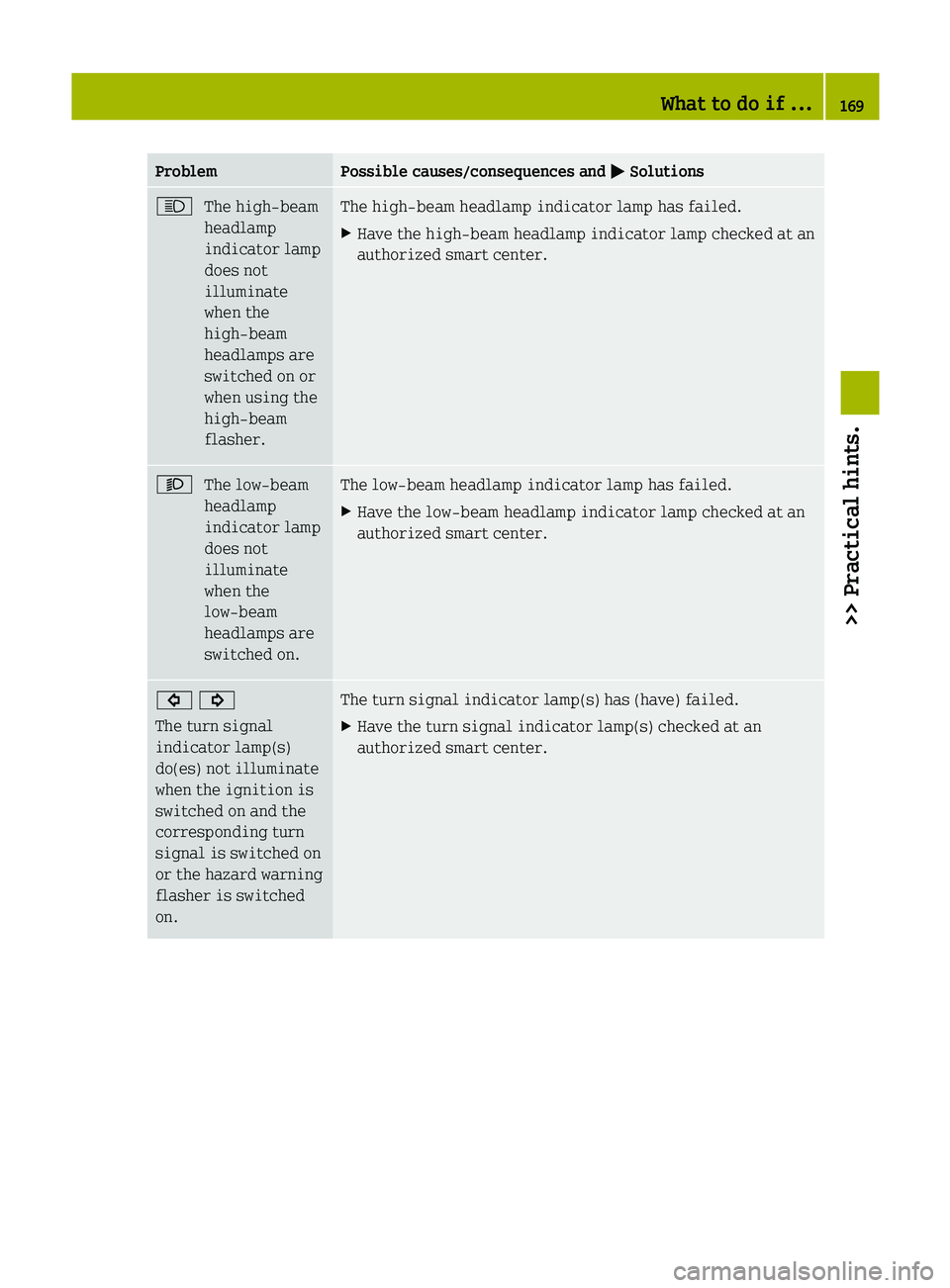
Problem Possible causes/consequences and
M SolutionsK
The high‑beam
headlamp
indicator lamp
does not
illuminate
when the
high‑beam
headlamps are
switched on or
when using the
high‑beam
flasher. The high‑beam headlamp indicator lamp has failed.
X
Have the high‑beam headlamp indicator lamp checked at an
authorized smart center. M
The low‑beam
headlamp
indicator lamp
does not
illuminate
when the
low‑beam
headlamps are
switched on. The low‑beam headlamp indicator lamp has failed.
X
Have the low‑beam headlamp indicator lamp checked at an
authorized smart center. # !
The turn signal
indicator lamp(s)
do(es) not illuminate
when the ignition is
switched on and the
corresponding turn
signal is switched on
or the hazard warning
flasher is switched
on. The turn signal indicator lamp(s) has (have) failed.
X
Have the turn signal indicator lamp(s) checked at an
authorized smart center. What to do if ...
169>> Practical hints. Z
Page 172 of 228
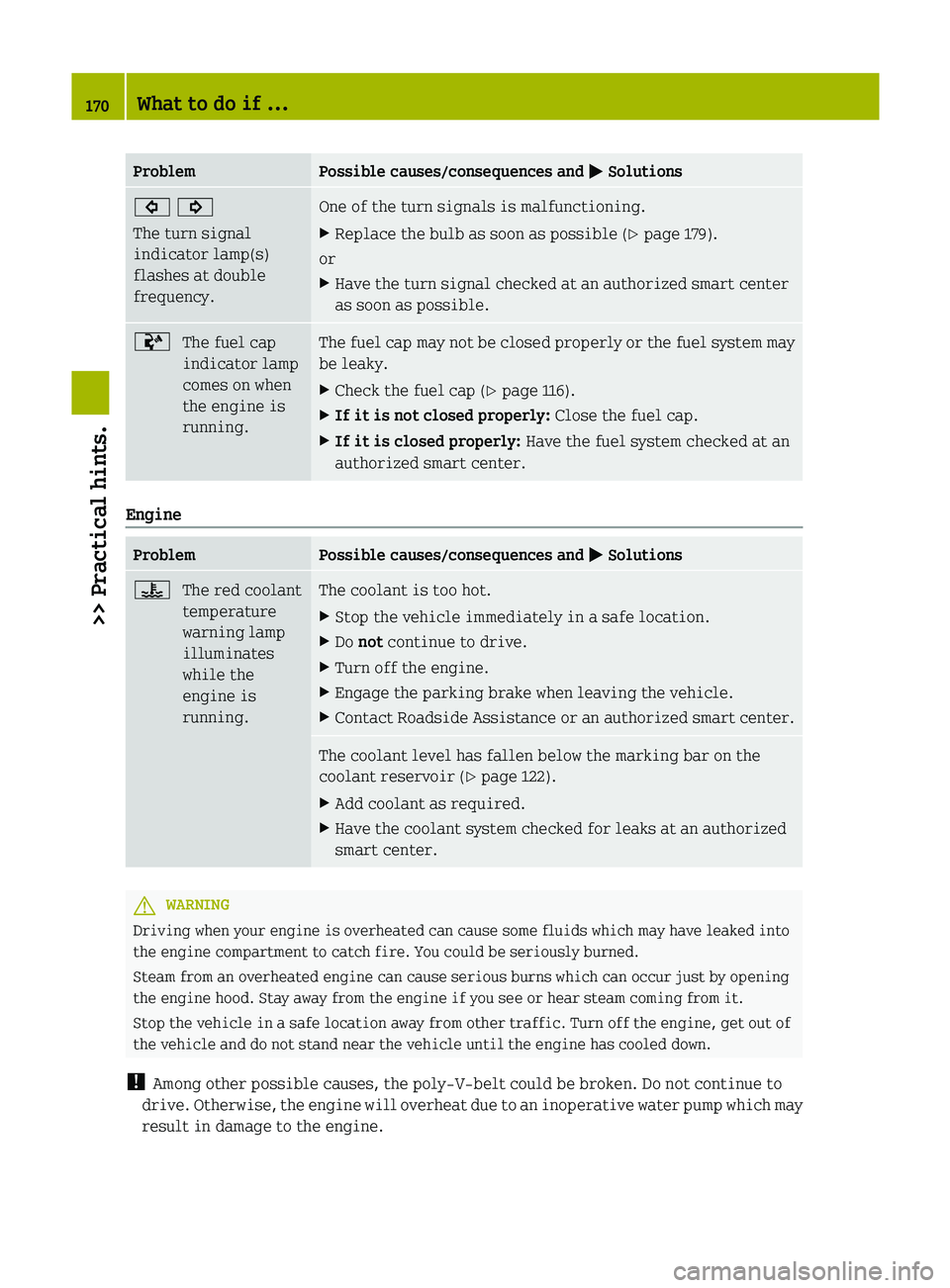
Problem Possible causes/consequences and
M Solutions# !
The turn signal
indicator lamp(s)
flashes at double
frequency. One of the turn signals is malfunctioning.
X
Replace the bulb as soon as possible ( Y page 179).
or
X Have the turn signal checked at an authorized smart center
as soon as possible. ®
The fuel cap
indicator lamp
comes on when
the engine is
running. The fuel cap may not be closed properly or the fuel system may
be leaky.
X
Check the fuel cap ( Y page 116).
X If it is not closed properly: Close the fuel cap.
X If it is closed properly: Have the fuel system checked at an
authorized smart center. Engine
Problem Possible causes/consequences and
M Solutions?
The red coolant
temperature
warning lamp
illuminates
while the
engine is
running. The coolant is too hot.
X
Stop the vehicle immediately in a safe location.
X Do not continue to drive.
X Turn off the engine.
X Engage the parking brake when leaving the vehicle.
X Contact Roadside Assistance or an authorized smart center. The coolant level has fallen below the marking bar on the
coolant reservoir (Y page 122).
X
Add coolant as required.
X Have the coolant system checked for leaks at an authorized
smart center. G
WARNING
Driving when your engine is overheated can cause some fluids which may have leaked into
the engine compartment to catch fire. You could be seriously burned.
Steam from an overheated engine can cause serious burns which can occur just by opening
the engine hood. Stay away from the engine if you see or hear steam coming from it.
Stop the vehicle in a safe location away from other traffic. Turn off the engine, get out of
the vehicle and do not stand near the vehicle until the engine has cooled down.
! Among other possible causes, the poly-V-belt could be broken. Do not continue to
drive.
Otherwise, the engine will overheat due to an inoperative water pump which may
result in damage to the engine. 170
What to do if ...
>> Practical hints.
Page 173 of 228
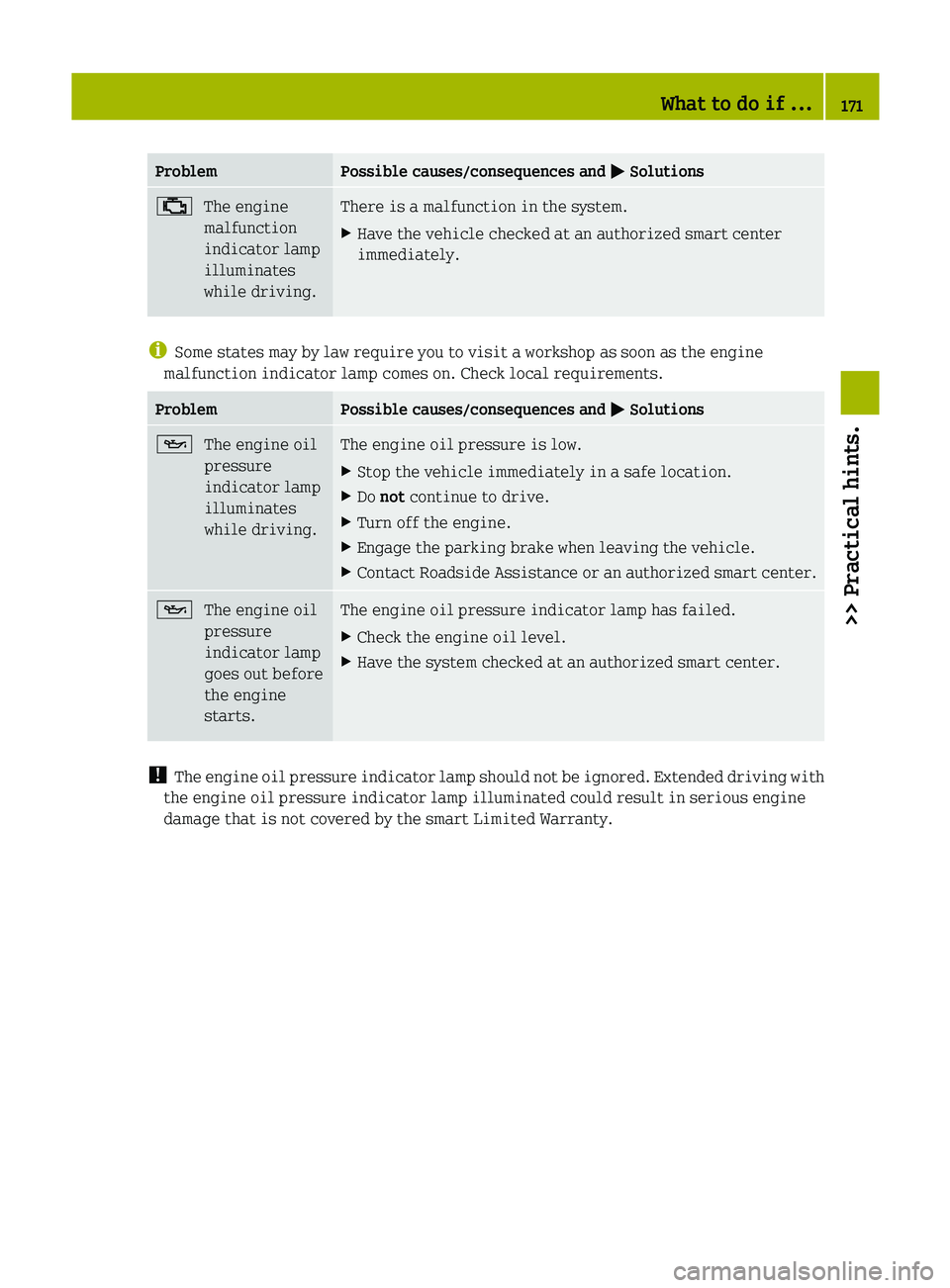
Problem Possible causes/consequences and
M Solutions;
The engine
malfunction
indicator lamp
illuminates
while driving. There is a malfunction in the system.
X
Have the vehicle checked at an authorized smart center
immediately. i
Some states may by law require you to visit a workshop as soon as the engine
malfunction indicator lamp comes on. Check local requirements. Problem Possible causes/consequences and
M Solutions5
The engine oil
pressure
indicator lamp
illuminates
while driving. The engine oil pressure is low.
X
Stop the vehicle immediately in a safe location.
X Do not continue to drive.
X Turn off the engine.
X Engage the parking brake when leaving the vehicle.
X Contact Roadside Assistance or an authorized smart center. 5
The engine oil
pressure
indicator lamp
goes out before
the engine
starts. The engine oil pressure indicator lamp has failed.
X
Check the engine oil level.
X Have the system checked at an authorized smart center. !
The engine oil pressure indicator lamp should not be ignored. Extended driving with
the engine oil pressure indicator lamp illuminated could result in serious engine
damage that is not covered by the smart Limited Warranty. What to do if ...
171
>> Practical hints. Z
Page 174 of 228
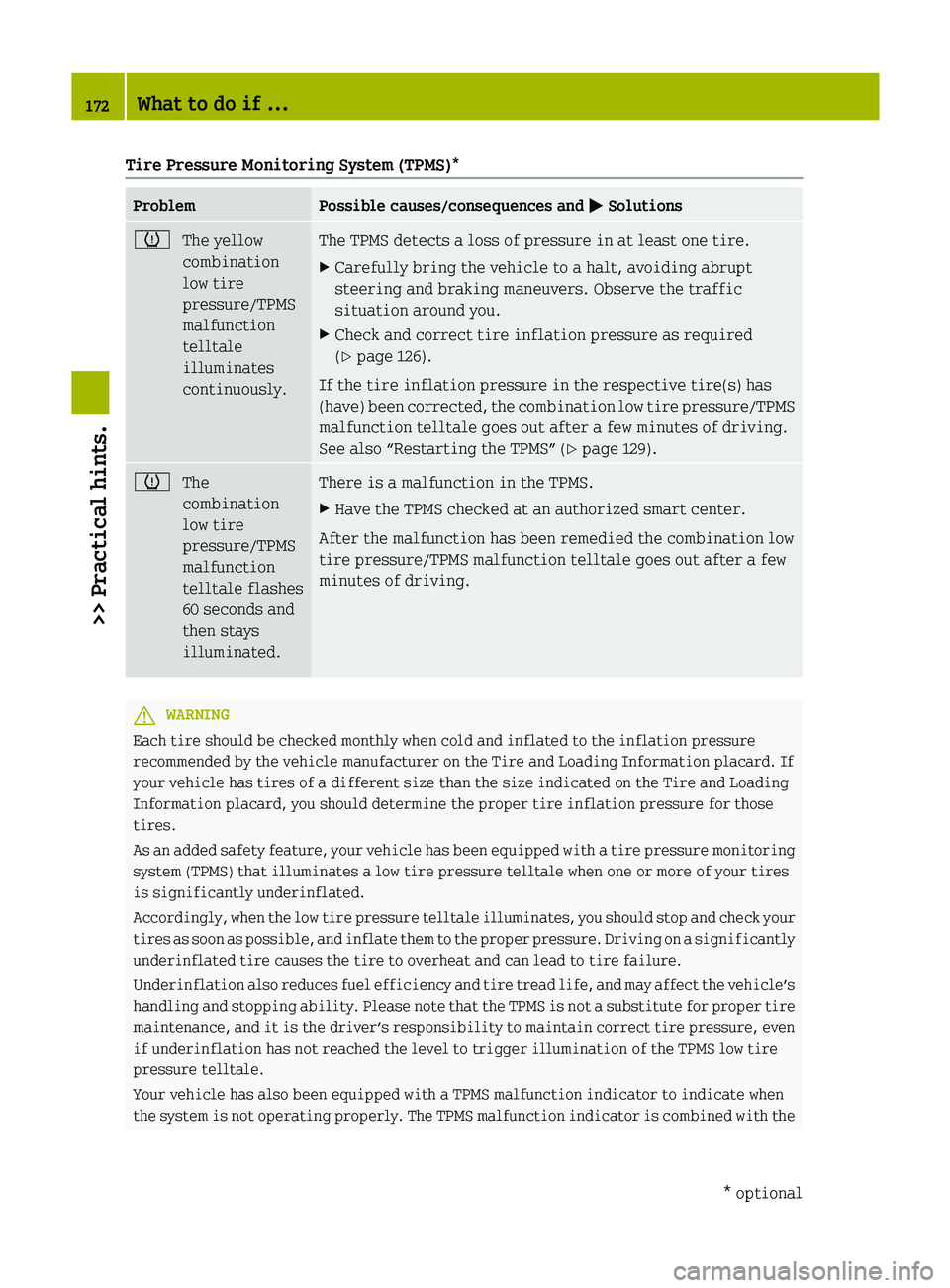
Tire Pressure Monitoring System (TPMS)*
Problem Possible causes/consequences and
M Solutionsh
The yellow
combination
low tire
pressure/TPMS
malfunction
telltale
illuminates
continuously. The TPMS detects a loss of pressure in at least one tire.
X
Carefully bring the vehicle to a halt, avoiding abrupt
steering and braking maneuvers. Observe the traffic
situation around you.
X Check and correct tire inflation pressure as required
(Y page 126).
If the tire inflation pressure in the respective tire(s) has
(have) been corrected, the combination low tire pressure/TPMS
malfunction telltale goes out after a few minutes of driving.
See also “Restarting the TPMS” (Y page 129). h
The
combination
low tire
pressure/TPMS
malfunction
telltale flashes
60 seconds and
then stays
illuminated. There is a malfunction in the TPMS.
X
Have the TPMS checked at an authorized smart center.
After the malfunction has been remedied the combination low
tire pressure/TPMS malfunction telltale goes out after a few
minutes of driving. G
WARNING
Each tire should be checked monthly when cold and inflated to the inflation pressure
recommended by the vehicle manufacturer on the Tire and Loading Information placard. If
your vehicle has tires of a different size than the size indicated on the Tire and Loading
Information placard, you should determine the proper tire inflation pressure for those
tires.
As
an added safety feature, your vehicle has been equipped with a tire pressure monitoring
system (TPMS) that illuminates a low tire pressure telltale when one or more of your tires
is significantly underinflated.
Accordingly, when the low tire pressure telltale illuminates, you should stop and check your
tires as soon as possible, and inflate them to the proper pressure. Driving on a significantly
underinflated tire causes the tire to overheat and can lead to tire failure.
Underinflation also reduces fuel efficiency and tire tread life, and may affect the vehicle’s
handling and stopping ability. Please note that the TPMS is not a substitute for proper tire
maintenance, and it is the driver’s responsibility to maintain correct tire pressure, even
if underinflation has not reached the level to trigger illumination of the TPMS low tire
pressure telltale.
Your vehicle has also been equipped with a TPMS malfunction indicator to indicate when
the system is not operating properly. The TPMS malfunction indicator is combined with the 172
What to do if ...
>> Practical hints.
* optional
Page 175 of 228
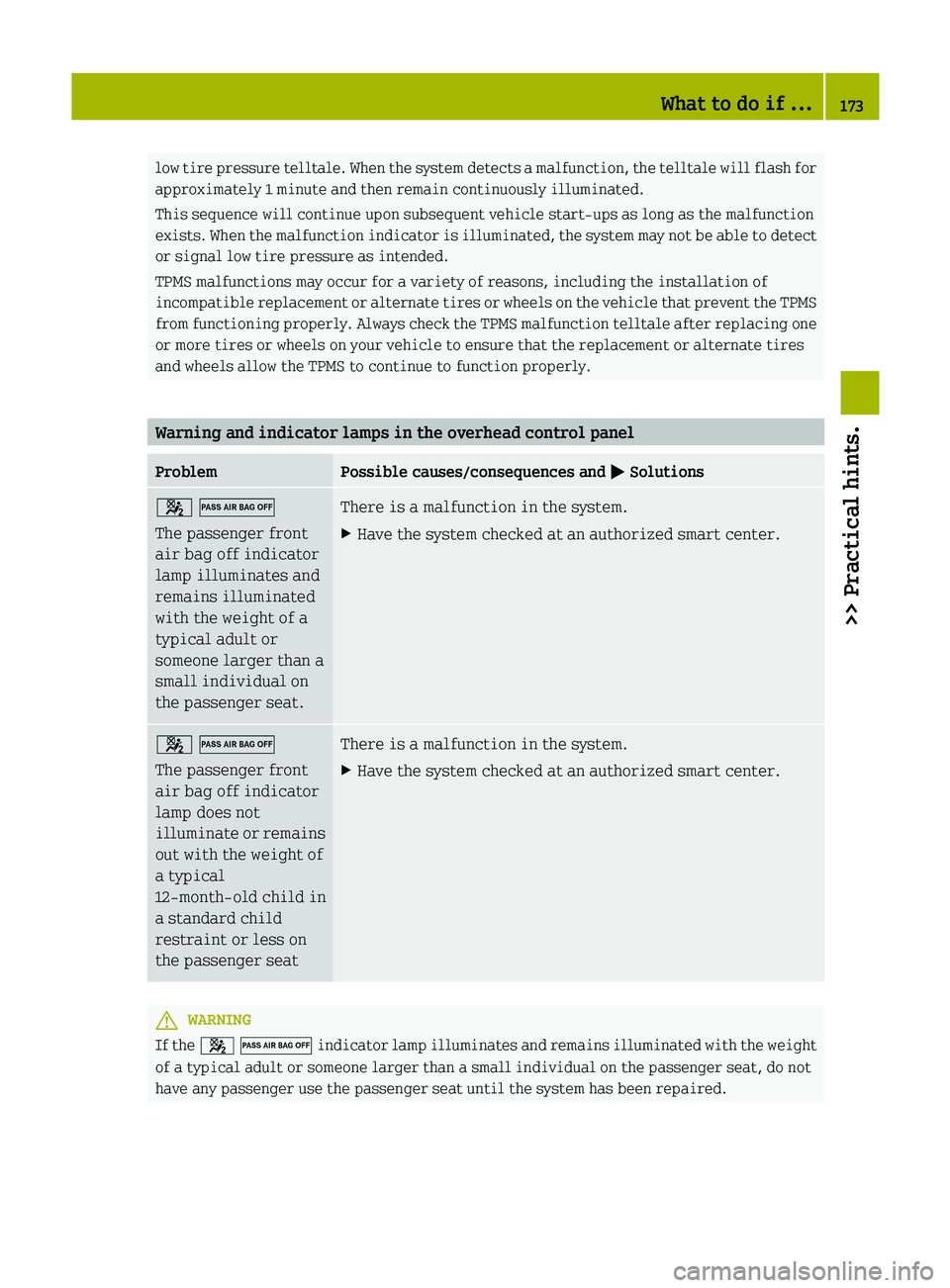
low tire pressure telltale. When the system detects a malfunction, the telltale will flash for
approximately 1 minute and then remain continuously illuminated.
This sequence will continue upon subsequent vehicle start-ups as long as the malfunction
exists.
When the malfunction indicator is illuminated, the system may not be able to detect
or signal low tire pressure as intended.
TPMS malfunctions may occur for a variety of reasons, including the installation of
incompatible replacement or alternate tires or wheels on the vehicle that prevent the TPMS
from functioning properly. Always check the TPMS malfunction telltale after replacing one
or more tires or wheels on your vehicle to ensure that the replacement or alternate tires
and wheels allow the TPMS to continue to function properly. Warning and indicator lamps in the overhead control panel
Problem Possible causes/consequences and
M Solutions4 0
The passenger front
air bag off indicator
lamp illuminates and
remains illuminated
with the weight of a
typical adult or
someone larger than a
small individual on
the passenger seat. There is a malfunction in the system.
X
Have the system checked at an authorized smart center. 4 0
The passenger front
air bag off indicator
lamp does not
illuminate
or remains
out with the weight of
a typical
12‑month‑old child in
a standard child
restraint or less on
the passenger seat There is a malfunction in the system.
X
Have the system checked at an authorized smart center. G
WARNING
If the 4 0
indicator lamp illuminates and remains illuminated with the weight
of a typical adult or someone larger than a small individual on the passenger seat, do not
have any passenger use the passenger seat until the system has been repaired. What to do if ...
173
>> Practical hints. Z
Page 176 of 228
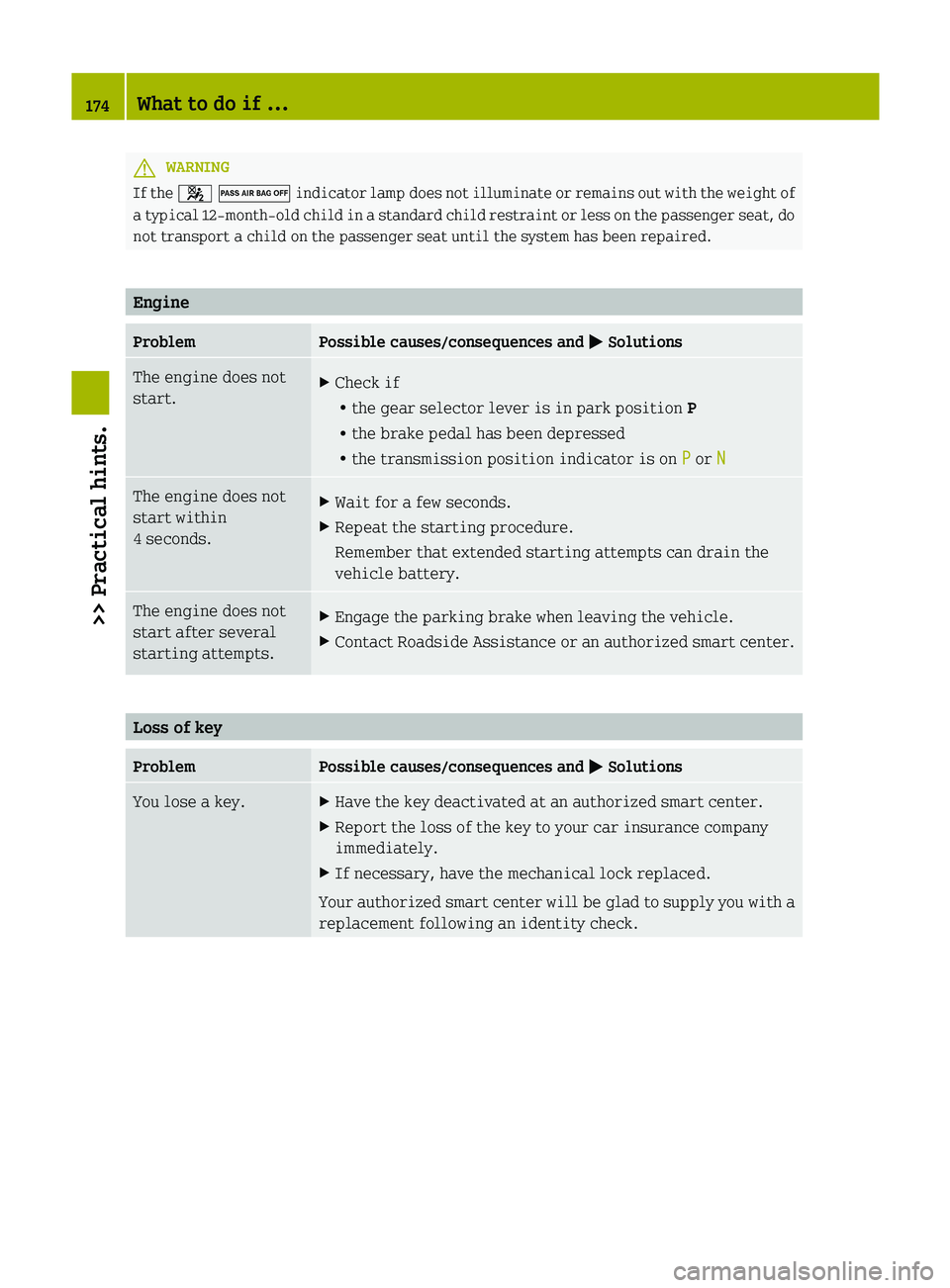
G
WARNING
If the 4 0 indicator lamp does not illuminate or remains out with the weight of
a typical 12‑month‑old child in a standard child restraint or less on the passenger seat, do
not transport a child on the passenger seat until the system has been repaired. Engine
Problem Possible causes/consequences and
M SolutionsThe engine does not
start.
X
Check if
R
the gear selector lever is in park position P
R the brake pedal has been depressed
R the transmission position indicator is on P or NThe engine does not
start within
4 seconds.
X
Wait for a few seconds.
X Repeat the starting procedure.
Remember that extended starting attempts can drain the
vehicle battery. The engine does not
start after several
starting attempts.
X
Engage the parking brake when leaving the vehicle.
X Contact Roadside Assistance or an authorized smart center. Loss of key
Problem Possible causes/consequences and
M SolutionsYou lose a key. X
Have the key deactivated at an authorized smart center.
X Report the loss of the key to your car insurance company
immediately.
X If necessary, have the mechanical lock replaced.
Your authorized smart center will be glad to supply you with a
replacement following an identity check. 174
What to do if ...
>> Practical hints.
Page 177 of 228

Acoustic warning signals
Problem Possible causes/consequences and
M SolutionsOnce the anti-theft
warning system* has
been armed, a visual
and audible alarm is
triggered. The alarm is triggered when
R
someone opens a door or the tailgate
R the driver’s door is unlocked with the key (Y page 176)
R the vehicle’s interior is entered
R there is motion inside the vehicle
R the vehicle is raised
To cancel the alarm:
X Insert the key in the starter switch.
X Turn the key to starter switch position 1.
or
X Press button # or * on the key.A warning signal
sounds. The door is opened while a gear is engaged with the engine
running and neither the brake nor accelerator pedals are
depressed.
X
Close the driver’s and passenger door.
X Move the gear selector lever to park position P.
or
X Turn off the engine. You open the driver’s door with the key in starter switch
position 0 to remind you not to leave the key in the vehicle.
X
Close the driver’s door.
or
X Remove the key from the starter switch. A warning signal
sounds. The seat belts are not fastened when the engine is started. For
details, see seat belt telltale (
Y page 165).
X Fasten your seat belts. What to do if ...
175>> Practical hints.
* optional Z
Page 178 of 228

Problem Possible causes/consequences and
M SolutionsA warning signal
sounds when parking. You have not engaged the parking brake before releasing the
brake pedal, turning off the engine, and switching off the
ignition.
X
Switch on the ignition to deactivate the acoustic warning.
X Engage the parking brake.
X Make sure the gear selector lever is in park position P.
X Turn the key to starter switch position 0.
X Remove the key from the starter switch.
For safety, it is important that you perform the parking
procedure as described (Y page 80). You can hear a
continuous
noise from
the front axle when
braking. The vehicle is equipped with a mechanical/acoustic brake pad
indicator.
X
Have the brake pads checked at an authorized smart center. Unlocking/locking manually
Unlocking the vehicle
You can unlock the driver’s door and the
fuel filler flap by unlocking the driver’s
door using the key. The lock cylinder is
fitted with a cap.
X Press button # on the key.
The anti-theft warning system* is
disarmed.
i If the transmitter battery in the key is
discharged, the anti-theft warning
system* can no longer be disarmed with
button # on the key.
For replacing the transmitter battery
(Y page 177).
Unlocking the vehicle with the key and
opening a door or the tailgate will
trigger the anti-theft warning system*
(Y page 48).
To cancel the alarm:
X Insert the key in the starter switch.
X Turn the key to starter switch position 1. X
Remove cap : from lock cylinder ;.
X Unlock the driver’s door.
The
driver’s door and the fuel filler flap
are unlocked.
i To unlock the vehicle centrally press
the
central unlocking switch in the upper
center console ( Y page 27). Locking the vehicle
If
you can no longer lock the vehicle using
the remote control and you do not have a
spare transmitter battery at hand, please
proceed as follows: 176
Unlocking/locking manually
>> Practical hints.
* optional
Page 179 of 228
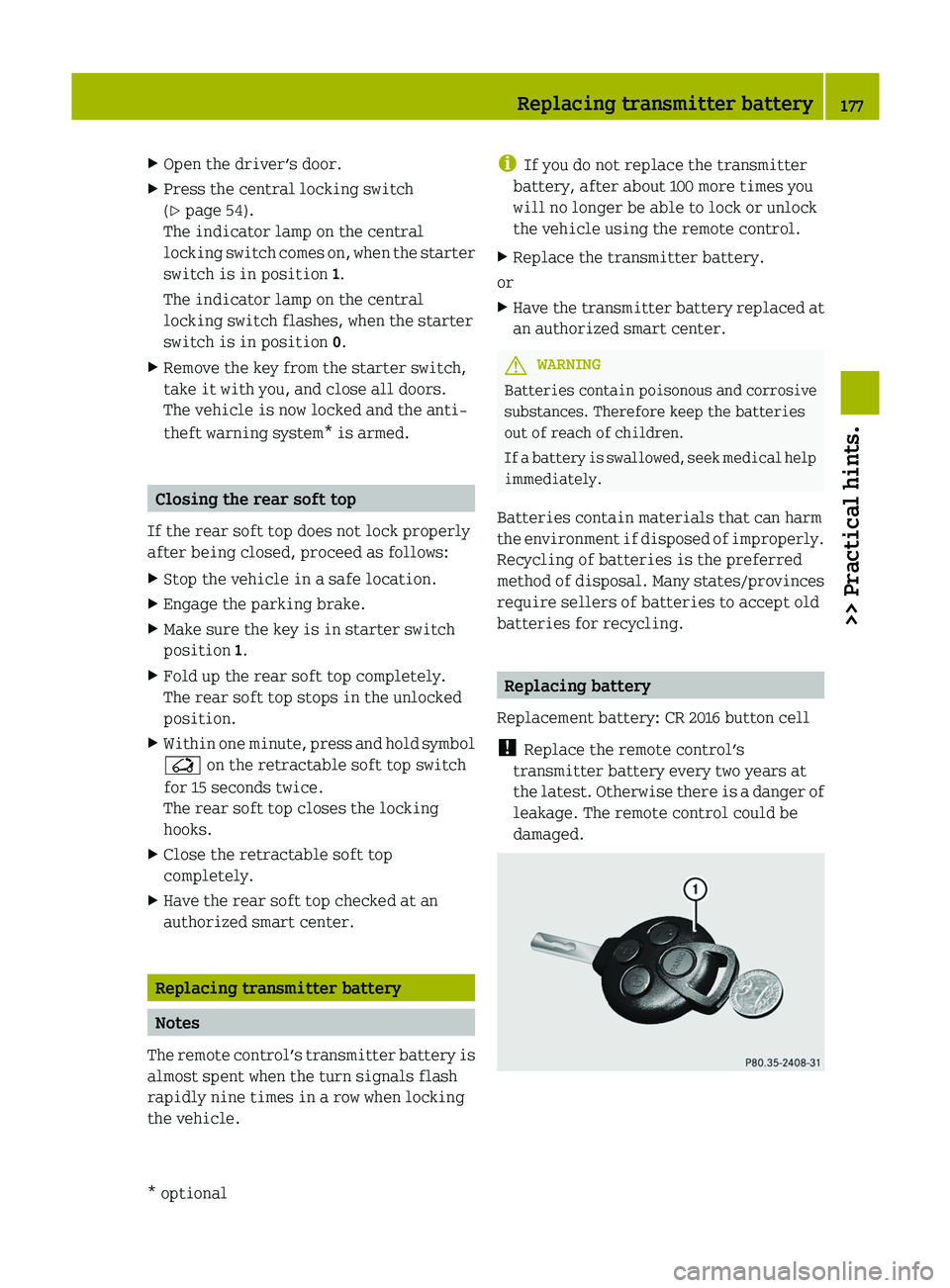
X
Open the driver’s door.
X Press the central locking switch
(Y page 54).
The indicator lamp on the central
locking
switch comes on, when the starter
switch is in position 1.
The indicator lamp on the central
locking switch flashes, when the starter
switch is in position 0.
X Remove the key from the starter switch,
take it with you, and close all doors.
The vehicle is now locked and the anti-
theft warning system* is armed. Closing the rear soft top
If the rear soft top does not lock properly
after being closed, proceed as follows:
X Stop the vehicle in a safe location.
X Engage the parking brake.
X Make sure the key is in starter switch
position 1.
X Fold up the rear soft top completely.
The rear soft top stops in the unlocked
position.
X Within one minute, press and hold symbol
G on the retractable soft top switch
for 15 seconds twice.
The rear soft top closes the locking
hooks.
X Close the retractable soft top
completely.
X Have the rear soft top checked at an
authorized smart center. Replacing transmitter battery
Notes
The
remote control’s transmitter battery is
almost spent when the turn signals flash
rapidly nine times in a row when locking
the vehicle. i
If you do not replace the transmitter
battery, after about 100 more times you
will no longer be able to lock or unlock
the vehicle using the remote control.
X Replace the transmitter battery.
or
X Have the transmitter battery replaced at
an authorized smart center. G
WARNING
Batteries contain poisonous and corrosive
substances. Therefore keep the batteries
out of reach of children.
If
a battery is swallowed, seek medical help
immediately.
Batteries contain materials that can harm
the environment if disposed of improperly.
Recycling of batteries is the preferred
method of disposal. Many states/provinces
require sellers of batteries to accept old
batteries for recycling. Replacing battery
Replacement battery: CR 2016 button cell
! Replace the remote control’s
transmitter battery every two years at
the
latest. Otherwise there is a danger of
leakage. The remote control could be
damaged. Replacing transmitter battery
177
>> Practical hints.
* optional Z
Page 180 of 228

X
Insert a suitable object such as a coin
into the slot at the eyelet of the key
housing.
X Carefully turn the coin until key housing
top half : is unlatched.
X Open key housing top half : to the side.X
Remove transmitter battery ; from the
board.
! Check the polarity when inserting the
new transmitter battery. You could
otherwise
damage parts of the electrical
system. When inserting the batteries,
make sure they are clean and free of lint.
X Insert the new transmitter battery.
X Press both halves of the key housing
together again.
X Check the operation of the remote
control. Replacing bulbs
About replacing bulbs
Safe vehicle operation depends on proper
exterior lighting and signaling. It is
therefore
essential that all bulbs and lamp
assemblies are in good working order at all
times.
Correct headlamp adjustment is extremely
important. Have headlamps checked and
readjusted at regular intervals and when a
bulb has been replaced. Contact an
authorized smart center for headlamp
adjustment. G
WARNING
Bulbs and bulb sockets can be very hot.
Allow
the lamp to cool down before changing
a bulb. Otherwise you could be burned if you
touch them.
Keep bulbs out of the reach of children.
Halogen lamps contain pressurized gas. A
bulb can explode if you:
R touch or move it when hot
R drop the bulb
R scratch the bulb
Wear eye and hand protection.
i If the headlamps or front fog lamps* are
fogged up on the inside as a result of
high humidity, driving the vehicle a
distance with the lights on should clear
up the fogging.
Notes on bulb replacement:
R Only use bulbs of the same type and with
the specified watt rating.
R Switch the lights off before replacing a
bulb to prevent short circuits.
R Always use a clean lint-free cloth when
handling bulbs.
R Your hands should be dry and free of oil
and grease.
R Avoid touching the glass of the bulb with
bare fingers.
R If the newly installed bulb does not come
on, contact an authorized smart center.
R Have the bulbs for the front fog lamps*
and the LED daytime running lamps*
replaced at an authorized smart center.178
Replacing bulbs
>> Practical hints.
* optional